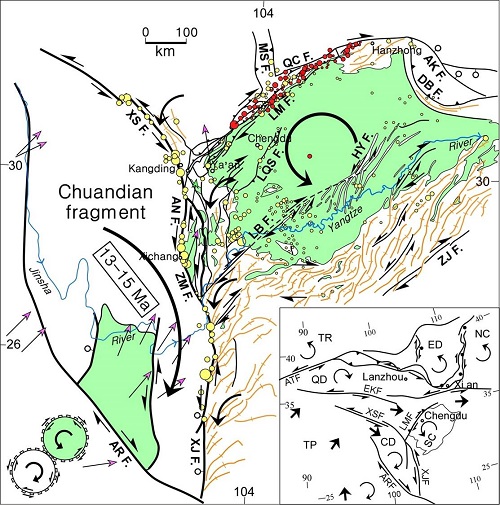Block rotation: Tectonic response of the Sichuan basin to the southeastward growth of the Tibetan Plateau along the Xianshuihe-Xiaojiang faultUpdate time:06 24, 2014
It is widely accepted that the May 12 2008, Wenchuan earthquake was triggered by the oblique convergence between the Tibetan plateau and the Sichuan basin along the Longmen Shan fault belt. However, this interpretation is not supported by the fact that the Longmen Shan fault belt is not an extremely seismically or tectonically active region. GPS and seismic data indicate that the southeastern margin of the Tibetan Plateau is tectonically and seismically active. This activity is due to the southeastward extrusion of the Chuandian fragment, a large crustal block rotating clockwise around the northeastern syntaxis of the Himalayas. The eastern boundary fault of this fragment is defined by the left-lateral Xianshuihe-Xiaojiang fault, which abruptly truncates the Sichuan basin of the Yangtze block. Our paper presents evidence that indicates that the Sichuan basin experienced right-lateral shear along its margin, which included the Longmen Shan fault belt, as indicated by the presence of a large number of interference deformation features. The features included S-shaped and Z-shaped folds and faults, aligned in an en echelon pattern. This study hypothesizes that the Sichuan basin experienced counterclockwise rotation, dragged by the left-lateral movement along the Xianshuihe fault and it is this rotation that was the underlying cause of the 12 May 2008 Wenchuan Ms 7.9 earthquake. During the rotation, the Sichuan basin decoupled along a subhorizontal decollement fault zone that developed along Triassic gypsum- and coal-bearing rocks, at a mean depth of ~5000 m, below which the Paleozoic rocks experienced much more intense deformation than the overlying Mesozoic rocks. This suggests that the lower part of the basin experienced a larger-scale rotation relative to the uppermost part of the basin. Based on thermal data from the western margin of the Sichuan basin and from along the Xianshuihe fault, the counterclockwise bending/rotation of the Sichuan basin initiated in late Cenozoic (~13 Ma). Tectonic model of counterclockwise rotation (curved arrows) for the Sichuan basin, in response to the southward extrusion of the Chuandian fragment along the XXF.
|
Contact
Related Articles
Reference
|
-
SIMSSecondary Ion Mass Spectrometer Laboratory
-
MC-ICPMSMultiple-collector ICPMS Laboratory
-
EM & TEMElectron Microprobe and Transmission Electron Microscope Laboratory
-
SISolid Isotope Laboratory
-
StIStable Isotope Laboratory
-
RMPARock-Mineral Preparation and Analysis
-
AAH40Ar/39Ar & (U-Th)/He Laboratory
-
EMLElectron Microscopy Laboratory
-
USCLUranium Series Chronology Laboratory
-
SASeismic Array Laboratory
-
SEELaboratory of Space Environment Exploration Laboratory
-
PGPaleomagnetism and Geochronology Laboratory
-
BioMNSFrance-China Bio-mineralization and Nano-structure Laboratory

 Print
Print Close
Close
